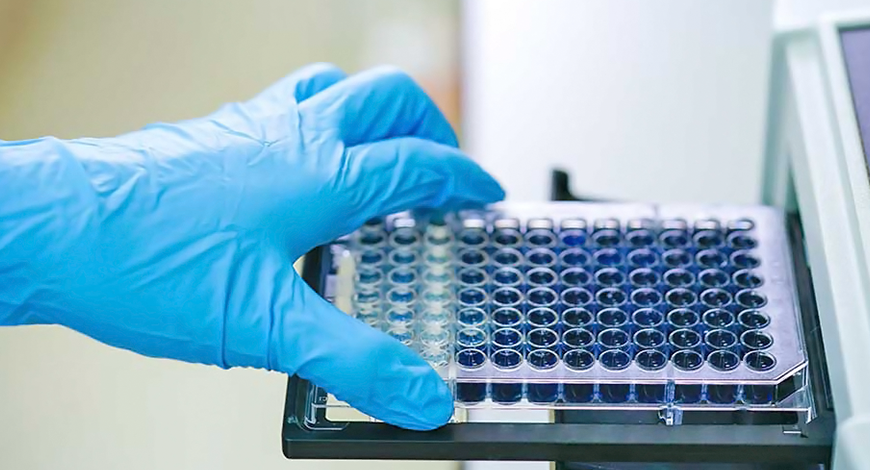Immunochemistry Instruments and Reagents
Bridging the gap between cells

Although the immunoassay field has mature segments, companies continue to develop immunoassays and immunoassay instrument platforms to improve assay sensitivity. Be it for determining a Vitamin-D deficiency or the presence of Covid-19 or HIV in clinical specimens; there are immunoassays for measuring each of these specific biomarkers.
ELISA is the most widely used immunoassay technique for the diagnosis of infectious diseases. This technique is used to measure antibodies, antigens, proteins, and glycoproteins in biological samples. Some examples include diagnosis of HIV infection, pregnancy tests, and measurement of cytokines or soluble receptors in cell supernatant or serum. Though the latest emerging technology, i.e., the multiplex proteomic array platform is rapidly replacing ELISA, its market continues to grow since it is being preferred as a secondary validation tool to confirm the results of multiplex proteomic platform.
With the development of signal-generation methods, the attention has shifted to the development of immunochemical methods and instruments to provide convenient, high-performance systems. Important advances have been made in the design of immunochemical approaches that allow small molecules, such as metabolites and toxins, to substitute dynamic format assays with non-competitive formats, bringing advantages previously seen only with large molecular analytes. Further, the continuous development of new biomarkers, cost-benefit, and growing adoption of automated platforms for ELISA are expected to increase this technology’s adoption.
Advancements and trends in ELISA tests
 JATIN MAHAJAN
JATIN MAHAJAN
Managing Director,
J Mitra & Co. Pvt. Ltd.
ELISA (Enzyme-linked immunosorbent assay) has been the primary analyte detection technique for over four decades. As a result, it has become vital to many areas of research and applications – from detecting food and environmental contaminants to screening for HIV and SARS-CoV-2 (Covid-19) antibodies.
Advantages
Because of its ability to test both antigens and antibodies, laboratories and medical professionals worldwide prefer the Elisa tests. Its primary advantages are:
-
Accuracy, quick results, and simplicity offer excellent sensitivity and high specificity;
-
Convenient for blood screening to detect infection markers. They are also applied in the food industry for detecting allergens and toxicology to screen for specific classes of drugs;
-
Highly efficient and easy to perform simultaneous analysis, without any complex sample pre-treatment;
-
Tests are eco-friendly and safe because they avoid the use of radioactive substances and solvents; and
-
Elisa tests are cost-effective, deploy low-cost reagents, are easy to automate with the ability to conduct 96 tests in a single assay with minimal handling.
Advancement and trends
Changes to the basic format have catalyzed assay improvements and automation. The upgrades include a phenomenal increase in assay sensitivity and widening of the dynamic range. Some automated platforms include new or alternative Elisa formats with miniaturized or microfluidic components. Recent developments in automatic plate washing and minimization of wash steps also impact conventional Elisa tests.
Safety concerns related to radioactivity have resulted in the rapid adoption of immunoassay techniques using enzyme labels. As a result, Elisa now has a higher number of immunoassays compared to RIA.
Another technology, CLIA, is usually available in the closed platform and needs massive investment. While Elisa technology can be performed on both open and automated systems and users are more familiar, CLIA is expensive for a low-volume sample load.
Elisa continues to be the technology of choice for medical professionals and laboratories tasked with analyte detection.
Bispecific antibodies and recombinant proteins are also beginning to impact immunodiagnostics. Due to the growing acceptance of smart devices, companies are developing automated lateral-flow readers connected to mobile phones or laptops. They can produce highly sensitive and quantifiable results and capture and transmit real-time data. Also, there has been high adoption of smart devices in healthcare systems for analysis and data management.
Immunoassays have long been widely used in various applications, such as medical diagnostics, pharmaceutical analysis, environmental, food safety testing, and basic scientific investigations, because of their simplicity, sensitivity, and specificity. However, most immunoassays include a series of washing, mixing, and incubation steps, which are labor-intensive and time-consuming.
Immunoagents used in immunoassays are relatively expensive. The consumption of the immunoagents can be greatly reduced if the system is miniaturized. Therefore, microfluidic systems, also known as a lab-on-a-chip or a micro-total-analysis-system, have attracted a lot of attention due to their advantages, such as miniaturization, integration, and automation.
Microfluidic devices are a new and diverse technology that uses fluids in micro environments in a controlled manner, distinguishing them from conventional nitrocellulose lateral-flow tests.
Microfluidic protein quantitation is a promising area for the point-of-care (POC) diagnosis of non-communicable diseases and severe infections, such as sepsis. Diagnosing these health conditions requires the accurate quantitation of very small amounts of biomarkers present in biological samples. Thus, the integration of microfluidics technology in immunoassay is expected to provide lucrative opportunities for the growth of the immunoassays market in coming years.
The global immunoassay market is projected to reach USD 39 billion by 2026 from USD 28.4 billion in 2021, at a CAGR of 6.6 percent. The EIA/ELISA segment dominates the market for immunoassay and held the largest revenue share of 64.3 percent in 2021. Some of the major advantages of this method over immunoelectrophoresis and immunodiffusion are reduced assay time, quantitative results, and requirement of limited amounts of antisera for analysis.
Despite the long history of immunoassay IVD kits and reagents and maturity of the field, companies continue to develop new immunoassays and instrument platforms to improve assay sensitivity. New developments expanding the future potential of immunoassays include making multiplexing possible, miniaturizing platforms for point of care testing, and identifying and developing assays for novel biomarkers.
The overall market for immunoassays is highly competitive and growing slowly, but has specific areas of opportunity that will be maximized. Many of the market’s tests are mature and have been available for years or decades. Significant growth opportunities in the immunoassay market may be possible through further innovations. This includes both new platforms and novel biomarkers. The attractive opportunities these innovations may make possible have attracted many diagnostics companies.
Leading names in immunoassays market will not surprise, and leading companies often lead in IVD as well.
The immunoassay market is large and, in some areas, locked up by large IVD companies, but there is plenty of opportunity for innovators and for niche players developing antibody or antigen-based tests.
In recent years, Roche Diagnostics has been very aggressive and has emerged as the immunoassay market leader. Roche excels in infectious disease and testing for women’s health, sepsis, Vitamin D, and a number of cancer markers.
Abbott, active in immunoassays since the 1980s, has secured the second market share position of the total global immunoassay market. Abbott generated most of its IVD sales outside the US but is slowly regaining ground in its home country through an effort to issue more FDA-cleared immunoassays. Alere, now merged with Abbott, participates in nearly all immunoassay POC test segments but has a dominating position in rapid cardiac markers, drugs of abuse, infectious disease, pregnancy, and fertility testing.
Beckman Coulter’s Access and Synchron systems provide a wide menu that is continuously enhanced with new tests. The company’s immunoassay menu consists of more than 60 tests for cancer detection, cardiac disease, thyroid function, reproductive endocrinology, and women’s health.
Other immunoassay leaders include bioMérieux, Bio-Rad, Thermo Fisher Scientific, Sysmex Corporation, Siemens Healthineers, Radiometer, DiaSorin, Fujirebio, and Ortho Clinical. More than 100 other companies compete for immunoassay market share, while smaller players with ELISA tests serve local markets.
Strong niche competitors such as Fujirebio, Tosoh, Wako, Thermo Fisher Scientific, and international companies market their products worldwide. Other smaller companies have experienced remarkable growth, but their total revenues only contribute small portions to the total market. As the average cost per test decreases with the migration of a number of immunoassays to integrated analyzers, the market’s capacity for growth becomes constrained.
What is next for ELISA? Over the past 40 years, technology has transformed many areas of scientific research. Polymerase chain reaction was initially carried out by manually incubating the reaction mix in water baths at different temperatures for varying times. Automated thermo-cyclers revolutionized the method by eliminating the labor-intensive incubation steps and dramatically increasing the reproducibility between reactions.
However, and despite all the advances and new technologies, ELISA has remained much the same as it once was. Certainly, there have been improvements and new takes on the classic ELISA but with the range and various types of ELISA available this was inevitable. Why?
For one thing, it is a safer alternative to its predecessor – radioimmunoassay. While radioimmunoassays are sensitive methods, which are far from obsolete, they use radioisotopes which require special precautions to protect the user, and special licensing.
Automation or partial automation designed to carry out full assays or individual steps, such as the delicate wash process reduce the setup time and standardize the steps, providing greater accuracy and sensitivity.
Moreover, the numerous variants of ELISA and multitude of detections available provide versatility and vast possibilities for future development and investigations with the assay. Mass spectrometric immunoassay (MSIA) is a new technology which is designed to provide fast and reproducible data using high throughput testing of large biomolecules. This new technology may be the future of immunoassays but due to high setup costs, along with training on the equipment, method and analysis, ELISAs will remain a firm favorite for the foreseeable future.
Along with being a great diagnostic tool, the different types of ELISAs have been employed by researchers as a highly sensitive analytical method. This holds especially true in the rapidly growing biosimilars market.
As one of the many methods available to characterize the similarity of a biosimilar molecule to its innovator, ELISAs have been at the forefront of this field. More recently, the FDAs demand for fingerprint-like identity of biosimilars has placed emphasis on the importance of a comprehensive and orthogonal characterization approach to maximize the potential to detect differences. To this end, ELISAs provide an important side of this approach – to define the similarity of biosimilar binding in comparison to the innovator drug. Exciting new ways to utilize the classic method in relation to the biosimilars characterization are being developed, such as bridging ADCC ELISA, which provides a link between the cells-based ADCC assay and ELISA, and ultimately demonstrate we can use an ELISA to measure ADCC.
The continued popularity of ELISA and its evolution means that it is likely to stick around as a core laboratory method for the foreseeable future! And, like in the 1960s, ELISA is once again bridging the gap between cells.












